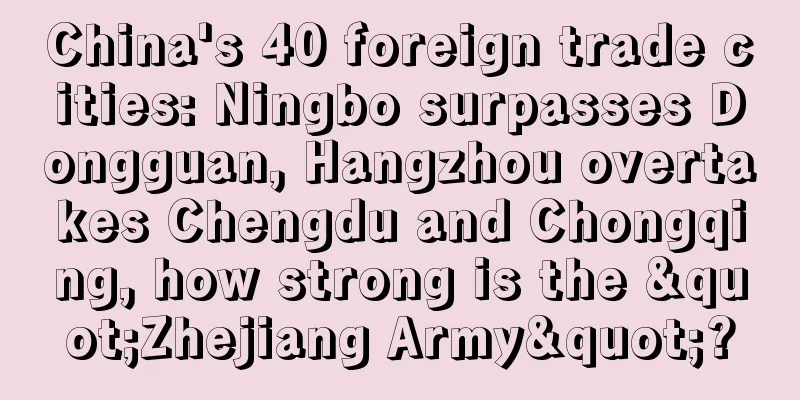China's 40 foreign trade cities: Ningbo surpasses Dongguan, Hangzhou overtakes Chengdu and Chongqing, how strong is the "Zhejiang Army"?

|
Author: Tan Zhongkui Source: Urban Evolution This article has been authorized by "Urban Evolution Theory" and is recommended for attention Foreign trade is the "barometer" for observing China's economic development, and the performance of core cities is the weather vane of the regional economy. Faced with a complex and severe external environment and multiple difficulties and challenges at home, my country's foreign trade showed strong resilience in the first three quarters of last year, with total imports and exports reaching 30.8 trillion yuan, a slight decrease of 0.2% year-on-year. Among them, exports were 17.6 trillion yuan, an increase of 0.6% year-on-year, and imports were 13.2 trillion yuan, a decrease of 1.2% year-on-year. Recently, the latest foreign trade data from various regions have been released one after another. In the process of gradual stabilization, the differentiation trend among major foreign trade cities remains significant. In terms of growth rate, among the top 40 cities in terms of total import and export volume in the first three quarters, 17 cities maintained positive growth. Among them, Chongzuo, Guangxi, adjacent to Vietnam, had an import and export growth rate of 41.4%, leading the 40 foreign trade cities in the country. Following closely behind were Jinhua and Shaoxing, two cities in Zhejiang, with import and export growth rates of 15.9% and 15.3% respectively. In terms of total volume, Shenzhen surpassed Beijing with a total import and export volume of 2.8 trillion yuan in the first three quarters, regaining the title of the second largest foreign trade city after Shanghai. At the same time, Ningbo surpassed Dongguan, and Hangzhou and Jinhua surpassed Chengdu and Chongqing, completing a historic promotion. China's 40 foreign trade cities are ushering in a new round of reshuffle. 0 1 Top Ten Camps Chase At the top of China's foreign trade cities, Shanghai's position as the "first city" is unshakable, with total imports and exports exceeding 3 trillion yuan in the first three quarters. Shenzhen and Beijing are both at the 2 trillion level, and Suzhou alone is at the 1 trillion threshold. After that, Ningbo and Dongguan are expected to reach 1 trillion, becoming the leading forces in China's foreign trade structure. In addition, Guangzhou, Xiamen, Qingdao, and Tianjin are also in the top ten. In fact, the competition between Beijing and Shenzhen for the second city has been going on for a long time. In 2019, the total import and export volume of Beijing and Shenzhen was 2.86 trillion yuan and 2.98 trillion yuan respectively, and the gap was still quite obvious; in 2022, the figures of the two cities were refreshed to 3.64 trillion yuan and 3.67 trillion yuan respectively, almost reaching the stage of "close combat". In the first eight months of last year, Beijing surpassed Shenzhen with a slight advantage, but now the latter is fighting back again - in the first three quarters, Shenzhen surpassed Beijing's 2.68 trillion yuan with a scale of 2.80 trillion yuan, returning to the second largest foreign trade city. The direct driving force behind Shenzhen is the rapid recovery of foreign trade in September. In September last year, Shenzhen's total import and export volume was 431.598 billion yuan, ranking first in the country. In particular, exports were 299.1 billion yuan, almost twice that of Shanghai and four times that of Beijing in the same period. This also made Shenzhen's import and export growth rate still reach 7.3% when the import growth rate in the first three quarters had not yet turned positive. According to data from the first eight months, Shenzhen's exports of mechanical and electrical products, including electronic components, mobile phones and lithium-ion batteries, reached 1.09 trillion yuan, accounting for 73.1%. Among them, the export of electric passenger cars reached 10.69 billion yuan, with a growth rate of 611.8%. In comparison, Beijing's imports contributed more to the growth of foreign trade. In the first three quarters of last year, Beijing imported 260.45 billion yuan of high-tech products, an increase of 25.4%, 32.2 percentage points higher than the national average, accounting for 9.9% of the country's imports of high-tech products in the same period. Among them, imports of biomedicine and medical instruments were 101.92 billion yuan, up 23.5%, accounting for 39.1% of Beijing's total imports of high-tech products during the same period, the highest proportion; imports of new energy vehicles were 7.85 billion yuan, up 106.6%, the fastest growth rate. The competition between Ningbo and Dongguan is also stalemate. In the first three quarters of last year, Ningbo's total import and export volume reached 955.105 billion yuan, and the growth rate narrowed to -0.6%. This also made it lead Dongguan by a slight advantage of about 3 billion yuan. Since it surpassed Dongguan in the first quarter of last year, it has continued to maintain its position as the fifth largest foreign trade city. Ningbo is a major foreign trade city that has taken the lead in "going overseas to grab orders". In the first three quarters of last year, while the overall trade volume with the two major trading partners, the EU and the United States, declined, Ningbo's imports and exports with ASEAN and Central and Eastern Europe grew rapidly, and the total import and export volume with the countries participating in the construction of the "Belt and Road" accounted for 44.1%. In terms of export commodities, Ningbo's mechanical and electrical products accounted for more than 50% of the export volume, among which the export volume of household appliances and automobiles increased by 10.5% and 48.7% respectively, and the "new three items" of foreign trade also grew rapidly. In contrast, the other two major foreign trade cities, Dongguan and Suzhou, seem to have not yet emerged from the shadow of foreign trade slowdown. Against the backdrop of international market fluctuations and foreign trade structural adjustments, the import and export growth rates of the two cities in the first three quarters were -12.8% and -9.7%, respectively, ranking last among the top ten. For the two cities, how to accelerate the upgrading of industrial structure and innovation-driven transformation and cultivate new foreign trade growth points has become a top priority. 0 2 The central and western regions collectively slowed down Looking further at the foreign trade performance of the 40 cities in the first three quarters, the cities in the Yangtze River Delta, especially those in Zhejiang, have collectively rebounded, which is equally significant as the slowdown in the central and western cities. The most obvious example is Hangzhou's overtaking of Chongqing and Chengdu. In the first three quarters of 2022, the total import and export volume of Chongqing and Chengdu was 625.955 billion yuan and 616.794 billion yuan respectively, while Hangzhou's import and export volume was only 581.068 billion yuan, a difference of more than 30 billion yuan. But now, the situation has suddenly changed - In the first three quarters of 2023, the total import and export volume of Hangzhou, Chengdu and Chongqing was 598.958 billion yuan, 552.252 billion yuan and 541.635 billion yuan respectively, up 3.3%, -10.4% and -12.5% year-on-year respectively. As a result, Hangzhou has surpassed Chongqing and Chengdu and ranked 11th among the national foreign trade cities. While foreign trade performance is outstanding, Hangzhou's interaction with the countries along the Belt and Road Initiative has significantly increased, and the activity of foreign investment has jumped to the forefront of the country. The Hangzhou Investment Promotion Bureau previously revealed that from January to August last year, Hangzhou actually utilized US$8.272 billion in foreign investment, a year-on-year increase of 53.13%. The total amount surpassed Guangzhou and Shenzhen for the first time, second only to Shanghai and Beijing, accounting for 6.7% of the country. Among them, investment from countries that jointly build the Belt and Road Initiative, such as Singapore, South Korea, and Turkey, has accounted for more than 50% of the actual use of foreign capital, and foreign trade growth is also very strong. This makes Hangzhou the biggest challenger to the "waist" order of the 40 foreign trade cities. At the same time, with the rapid recovery of Yiwu, the "world supermarket", Jinhua also successfully achieved a counterattack. In the first three quarters of 2023, Jinhua's total import and export volume reached 586.138 billion yuan. With an import and export growth rate of 15.9%, Jinhua surpassed Foshan, Wuxi, Chengdu and Chongqing in succession, ranking 12th in the country. Compared with the same period in 2022, there is still a 100 billion-level step between Jinhua and Chengdu and Chongqing. Such a speed of catching up is really surprising. In sharp contrast, foreign trade in central and western cities has collectively slowed down. Among the 40 cities, Xi'an, Changsha and Zhengzhou ranked last with import and export growth rates of -19.9%, -13.8% and -13.8% in the first three quarters respectively. In addition, Chongqing and Chengdu also saw import and export declines of more than 10%; Wuhan fell by 8.1% and Hefei also fell by 4.1%. The reason for this is that, compared with coastal areas, the foreign trade structure of central and western cities is relatively simple and they rely more heavily on leading enterprises, so it takes longer to adapt to and avoid external factors such as geopolitics. "An important reason for this may be that the European share has declined." Xu Hongcai, deputy director of the Economic Policy Committee of the Chinese Academy of Policy Sciences, analyzed to Chengshu that the China-Europe Express plays the role of the Eurasian Continental Bridge, but due to factors such as the Russian-Ukrainian conflict and weak economic growth in Europe, the overall demand is declining. Coastal cities can use the Maritime Silk Road to radiate to Southeast Asia and other emerging economies, and their relative advantages are more obvious. At the same time, global goods trade growth is relatively weak, while the proportion of digital trade has increased. "Some places where goods trade used to be dominant will definitely be affected, while coastal areas, including Shenzhen and Hangzhou, have a stronger momentum of digital economic development." Xu Hongcai pointed out that this structural factor will also lead to different foreign trade performance. 0 3 Why is the “Zhejiang Legion” so strong? At present, Jinhua's total import and export volume is 14 billion yuan away from Tianjin, which ranks 10th in the country, and Hangzhou is only one step away. Looking at the whole year, Hangzhou and Jinhua both have the confidence to challenge the top ten foreign trade countries, which also sends a strong signal that Zhejiang's foreign trade is recovering rapidly. In fact, looking at the 40 foreign trade cities, Zhejiang accounts for 7 of the 17 cities that achieved positive growth in the first three quarters of 2023. Jinhua, Shaoxing, and Zhoushan's import and export growth rates were 15.9%, 15.3%, and 7.7%, respectively, ranking second, third, and fourth, second only to Chongzuo; Hangzhou, Jiaxing, Wenzhou, and Taizhou also reached 3.3%, 1.9%, 1.7%, and 1.2%, respectively. Ningbo, the only city with negative growth, fell slightly by 0.6%, and its resilience was also strong. "Zhejiang's advantage lies mainly in its developed private economy, which is very flexible and sensitive in capturing new business opportunities in the international market." Xu Hongcai said that Zhejiang has organized "going overseas to grab orders" in Europe, Japan, the United States and other places since the beginning of the year, and has done a lot of work. At the same time, many places such as Wenzhou, Taizhou, and Ningbo are hometowns of overseas Chinese, and they have international influence in some overseas fields and brands. For example, Yongkang's hardware products are world-renowned and its innovation ability is also very strong. Overall, in the first three quarters of 2023, Zhejiang's total import and export value was 3.70 trillion yuan, a year-on-year increase of 5.0%, ranking first among the six major economic provinces of Guangdong, Jiangsu, Zhejiang, Shandong, Henan and Sichuan. Among them, exports were 2.71 trillion yuan, an increase of 4.4%, and imports were 981.62 billion yuan, an increase of 6.8%. Especially in the third quarter, Zhejiang's import and export, export and import scales all hit historical quarterly highs, up 3.7%, 2.2% and 8.0% year-on-year respectively. From the perspective of the top three trading partners, Zhejiang's imports and exports to the EU and the United States both showed negative growth. During the same period, Zhejiang's imports and exports to countries participating in the Belt and Road Initiative reached 1.93 trillion yuan, up 10.8%, driving the province's imports and exports up 5.3 percentage points. This also shows that Zhejiang's foreign trade structure is adjusting rapidly. In this regard, Xu Hongcai once again mentioned the added effect of digital economy on foreign trade. For example, Hangzhou has a unique development in the field of digital economy. Digital economic platforms such as Alibaba have emerged, their business radiates across the country, and digital trade is also booming. In contrast, the overall layout of digital economy in the central and western regions is relatively slow. In addition, in Xu Hongcai's view, the transformation and upgrading of foreign trade structure is a common problem, and the real particularity of central and western cities lies in—— Zhejiang, Fujian, Guangdong and other places are mainly small commodity exports, private enterprises dominate, and have great flexibility. The central and western regions are more supported by "big guys" enterprises, and small and medium-sized enterprises are relatively weak. Therefore, the focus of the central and western regions in the future should be to support the development of small, medium and micro enterprises, so that the overall foreign trade resilience can be further enhanced. He believes that local governments should further optimize the business environment and protect the enthusiasm of private and foreign-invested enterprises. "To eliminate risks and diversify, we still have to rely on thousands of small and medium-sized enterprises." Xu Hongcai further pointed out that "the United States, Europe, and Japan may need more electronic consumer products, while countries that jointly build the 'Belt and Road', such as Africa, may need more intelligent and mechanized industrial production equipment such as agricultural machinery and equipment. The demand structure is different, and we must also transform in a new direction." |
<<: "After being laid off by a large company, I turned the tide overseas"
>>: Big news! The US will cancel the $800 import duty-free policy! Temu and SHEIN are hit hard
Recommend
What is Auction.co.kr? Auction.co.kr Review
Auction is the largest online e-commerce auction w...
Behind the Amazon Prime Day hits, here are 3 tricks of the operators!
This is my 735th day in e-commerce operations: Loo...
What is Texun Information? Texun Information Review
Shenzhen Texun Information Consulting Management C...
Major adjustment of the US dollar exchange rate! Many big sellers seized the opportunity to expand against the trend
Today, the central bank announced the latest RMB e...
Amazon backend login password is wrong! How to tell if the account is frozen?
So how do you tell if your account is frozen? Don...
Competition heats up as Amazon and Temu race to explore diversified supply chains
According to the latest foreign media reports, two...
Important! Amazon's recent new features + Apollo control ACoS system
text Brand owners can now view search query perfor...
What is power of attorney? Power of attorney review
power of attorney: A letter of authorization or po...
What should I do if I cannot log in to my Amazon account?
Generally, this type of problem is caused by these...
What is Qianbao Payment? Qianbao Payment Review
Qianbao is one of the earliest companies in China ...
(Internal gameplay) This set of operating methods is suitable for daily sales of thousands of orders
Strategy 1 1. After the new product is launched, i...
What is Coupang? Coupang Review
Coupang is a South Korean e-commerce company and t...
FBA shipping costs increased by nearly 60%! Amazon...
According to foreign media reports, Amazon has inc...
FDA says it will take two months for U.S. infant formula shipments to return to normal! Abbott to resume production soon
<span data-shimo-docs="[[20,"获悉,5月26日美国食品和...
What is Instagram? Instagram Review
Instagram (Photo Wall) is an application that prov...









